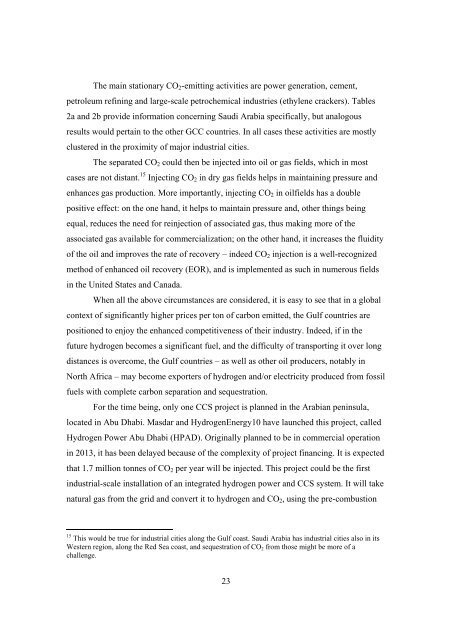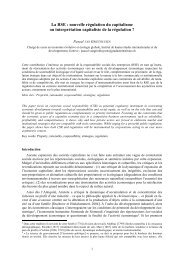PDF - Graduate Institute of International and Development Studies
PDF - Graduate Institute of International and Development Studies
PDF - Graduate Institute of International and Development Studies
Create successful ePaper yourself
Turn your PDF publications into a flip-book with our unique Google optimized e-Paper software.
The main stationary CO 2 -emitting activities are power generation, cement,<br />
petroleum refining <strong>and</strong> large-scale petrochemical industries (ethylene crackers). Tables<br />
2a <strong>and</strong> 2b provide information concerning Saudi Arabia specifically, but analogous<br />
results would pertain to the other GCC countries. In all cases these activities are mostly<br />
clustered in the proximity <strong>of</strong> major industrial cities.<br />
The separated CO 2 could then be injected into oil or gas fields, which in most<br />
cases are not distant. 15 Injecting CO 2 in dry gas fields helps in maintaining pressure <strong>and</strong><br />
enhances gas production. More importantly, injecting CO 2 in oilfields has a double<br />
positive effect: on the one h<strong>and</strong>, it helps to maintain pressure <strong>and</strong>, other things being<br />
equal, reduces the need for reinjection <strong>of</strong> associated gas, thus making more <strong>of</strong> the<br />
associated gas available for commercialization; on the other h<strong>and</strong>, it increases the fluidity<br />
<strong>of</strong> the oil <strong>and</strong> improves the rate <strong>of</strong> recovery – indeed CO 2 injection is a well-recognized<br />
method <strong>of</strong> enhanced oil recovery (EOR), <strong>and</strong> is implemented as such in numerous fields<br />
in the United States <strong>and</strong> Canada.<br />
When all the above circumstances are considered, it is easy to see that in a global<br />
context <strong>of</strong> significantly higher prices per ton <strong>of</strong> carbon emitted, the Gulf countries are<br />
positioned to enjoy the enhanced competitiveness <strong>of</strong> their industry. Indeed, if in the<br />
future hydrogen becomes a significant fuel, <strong>and</strong> the difficulty <strong>of</strong> transporting it over long<br />
distances is overcome, the Gulf countries – as well as other oil producers, notably in<br />
North Africa – may become exporters <strong>of</strong> hydrogen <strong>and</strong>/or electricity produced from fossil<br />
fuels with complete carbon separation <strong>and</strong> sequestration.<br />
For the time being, only one CCS project is planned in the Arabian peninsula,<br />
located in Abu Dhabi. Masdar <strong>and</strong> HydrogenEnergy10 have launched this project, called<br />
Hydrogen Power Abu Dhabi (HPAD). Originally planned to be in commercial operation<br />
in 2013, it has been delayed because <strong>of</strong> the complexity <strong>of</strong> project financing. It is expected<br />
that 1.7 million tonnes <strong>of</strong> CO 2 per year will be injected. This project could be the first<br />
industrial-scale installation <strong>of</strong> an integrated hydrogen power <strong>and</strong> CCS system. It will take<br />
natural gas from the grid <strong>and</strong> convert it to hydrogen <strong>and</strong> CO 2 , using the pre-combustion<br />
15 This would be true for industrial cities along the Gulf coast. Saudi Arabia has industrial cities also in its<br />
Western region, along the Red Sea coast, <strong>and</strong> sequestration <strong>of</strong> CO 2 from those might be more <strong>of</strong> a<br />
challenge.<br />
23




